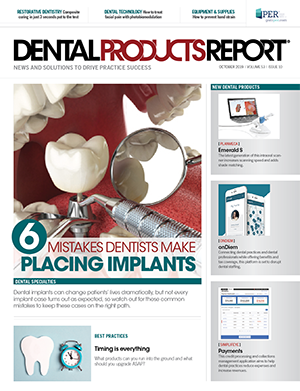Timing is everything
What products can you run into the ground and what should you upgrade ASAP? Our experts weigh in on how timing is everything when managing your practice purchases. [ by Terri Lively ]
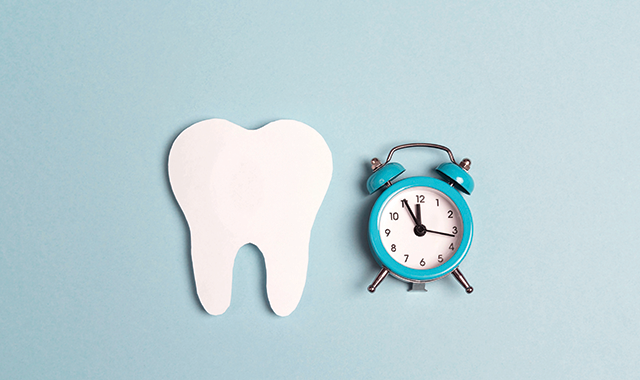
There is no shortage of ways for you to spend money on your practice. However, most practices must see a significant return on any investment made. As you sort through the deluge of opportunities to separate yourself from your hard-earned cash, it is critical to consider what you should upgrade as often as possible and what you can possibly use forever.
Jason Goodchild, DMD, Director of Clinical Affairs for Premier Dental Products Company, says it is not always necessary to have the latest and greatest technology. There are plenty of dentists who use what some might consider antiquated technology but still provide excellent patient care.
“New and shiny doesn’t always mean better. Sometimes it just means more expensive,” Dr. Goodchild says.
Jeff Lineberry, DDS, a general and cosmetic dentist who practices in Mooresville, N.C., agrees that all expenditures are not equally critical. There are areas where he focuses his attention and other equipment and technology that he uses for years and years to deliver excellent patient care.
“I could pick up a handpiece from 20 years ago and still produce good work,” Dr. Lineberry says.
John Flucke, DDS, and Technology Editor for Dental Products Report, loves gadgets and technology, but he agrees they’re not all essential items. He has a decision matrix approach to investing in his practice. Before sizeable technology investments, Dr. Flucke asks himself three questions in this order:
- Does it let me do what I want to and get better results or at least the same results I get now?
- Does it make the procedure faster?
- Can I afford it?
“You can also put in there, ‘Can I do things that I’m not currently doing?’ That’s huge,” Dr. Flucke says of his buying decision process.
Dr. Goodchild favors the approach of remembering what a “must-have” item is and what is “nice-to-have.” If he were considering an upgrade, Dr. Goodchild says he would weigh the short-term expense of the purchase against the long-term gain for the practice.
“Will I be able to do dentistry faster? More importantly, will the expenditure allow me to do better dentistry? Is it better, safer, faster? For me, that speaks to the return on investment, and that’s a big question,” Dr. Goodchild says.
So, what should you upgrade? Here are three areas of the practice our experts agree are a good investment for your practice.
Continue reading on the next page...
Your radiography and imaging
Many dentists feel like they can still function fine with film radiography. Moreover, for many years, that was all that was available, and dentists provided excellent patient care with it. Dr. Goodchild thinks that dental radiology and imaging is an area where dentists need to upgrade from film if they haven’t already.
Digital radiography has many benefits, like improved visuals in the oral cavity, increased communication between providers, and reduced doses of radiation administered to patients. However, dentists might not yet have invested because they have been concerned about the price tag. Still, Dr. Goodchild believes the time is ripe to invest in digital radiology.
“There’s just no reason not to,” Dr. Goodchild says. “Price isn’t overwhelming anymore. It used to be quite expensive, but now it is much more affordable.”
Dr. Goodchild also says some dentists should consider investing in Cone Beam Computer Tomography (CBCT) technology and the 3D side of imaging. Besides providing enhanced views of areas previously hard to visualize, CBCT technology can contribute to better co-diagnosis with patients.
“You can show patients on a big screen monitor what’s going on in much great detail and involve them in the treatment decisions,” Dr. Goodchild says.
CBCT and intraoral digital radiography allows you to talk about treatment options in more depth as well. When the patient can see what you see, it improves patient treatment acceptance rates, which is excellent for the return on the investment side of things.
“Digital radiography also allows integration with a lot of these new software systems where you can do smile mockups. You can show them what treatment outcomes may look like to improve planning and communication, and ultimately get the needed patient buy-in,” Dr. Goodchild explains.
Intraoral cameras such as these from MouthWatch make it easy and affordable to capture intraoral images for documentation and case presentation, according to our experts.
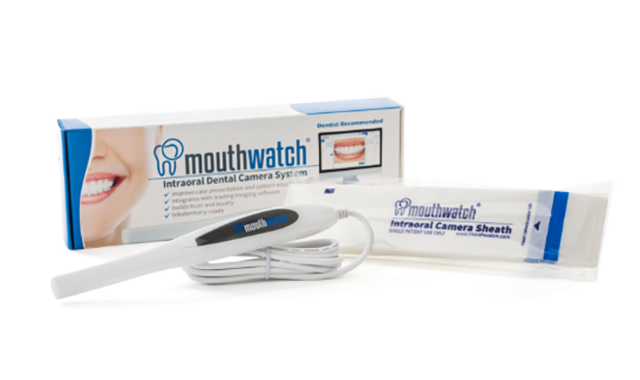
Dr. Flucke agrees about radiography and imaging with a digital sensor, adding you should not forget about intraoral cameras. He likes using them to enhance patient education during treatment planning.
However, he does not think you need a state-of-the-art digital camera. The images you get with a good camera are sufficient for patient education purposes. He likes the intraoral cameras from MouthWatch because he says they make great cameras for an affordable price, around $300.
“In my opinion, the days of the $3,500 camera are gone,” Dr. Flucke says.
Continue reading on the next page...
Your information security
Many dentists have not upgraded their security enough. It’s an area that some doctors let slide or do not think about at all. However, Dr. Flucke says that with today’s HIPAA concerns and the prevalence of data breaches, you cannot afford to skimp on your data security.
“Doctors get hung up on this thing of, ‘It’s dentistry. Nobody cares. It’s not like there’s any terrible problem that would be in our records that you would want to hide from people,’” Dr. Flucke says. “But’s that’s not what the thieves want. They want the demographic info.”
A patient’s record has their demographic information, home address, phone number, Social Security number, birth date, and maybe even their credit card number. Dr. Flucke says in his patient record, they often have family members and their birthdates as well.
“People use their kid’s names or birthdates of their children for computer passwords and other things. People don’t think about what is in there that could wreak havoc in somebody’s life,” Dr. Flucke says.
To put it in perspective, Dr. Flucke says a credit card number on the black market goes for 50 cents. However, a medical record goes for $50.
“What we’re sitting on in our networks is a huge amount of money for nefarious people,” Dr. Flucke explains. “It’s worth it for them to try to break-in.”
Dr. Flucke says there are two significant consequences if you do not upgrade your practice’s data security. First, you do not want to be responsible for that kind of data breach for one of your patients because of the nuisance it is for them. Second, you don’t want Health and Human Services getting involved and then getting hit with a six-figure fine because you didn’t protect the patient information the way you should.
Continue reading on the next page...
Your restorative materials
Dr. Lineberry encourages dentists to stay on top of developments with materials because they often improve, and they are in your hands every day. His practice has a lot of restorative and cosmetic work that uses different types of composite and bonding systems, so he is always interested in product developments in materials.
“Materials are always improving with performance and physical properties. You want to ensure you are using the latest and the greatest,” Dr. Lineberry says.
Restorative materials, whether direct or indirect, are always improving. Dentists should be updated on new developments with matierals because of their daily use.
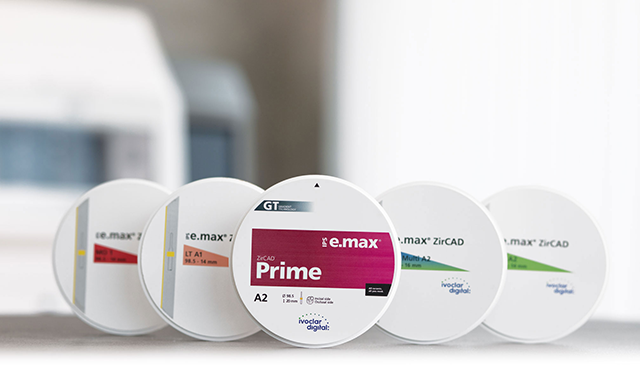
Also, some of the indirect materials such as lithium disilicates (e.g. IPS e.max products from Ivoclar Vivadent), and zirconia have improved a lot in performance, Dr. Lineberry says. He didn’t have these available when he first graduated from dental school, but over time he has incorporated them into his practice and thinks they produce excellent restorations.
He encourages dentists to try new things and get comfortable with different materials by attending continuing education courses and monitoring the dental literature. Otherwise, you run the risk of getting stuck in a rut with restorative materials and miss out on the improvements available.
“Sure, you can use Herculite composite that came out 20 years ago. It’s proven, and it will work, but chances are, it has improved in the recent past,” Dr. Lineberry says.
Dr. Flucke agrees that you should follow new developments in materials. While there are always going to be materials that are tried and true, advances in them can make a significant difference in your productivity and efficiency.
“There are some things like the new OMNICHROMA from Tokuyama, which is a single shade composite. When you put it in the tooth, it pulls in the color of the surrounding structure. It matches 90 to 95 percent of the situations that I use it in. That’s something I am glad I have,” Dr. Flucke says.
However, Dr. Flucke also cautions dentists not to run out and buy every iteration of a product, either. For example, if you use XYZ company’s 4.0 brand composite, and they come out with version 5.0, Dr. Flucke says you don’t have to upgrade right away. Many of the material improvements for long-standing composite materials are not always significant enough to change clinical outcome when existing materials are used appropriately.
Dr. Flucke uses shade matching as an example. Many improved composites tout their improved shade matching to the shade guides. However, as long as it’s tooth-colored, it did not require them to sit in the chair with their mouth open for 90 minutes, and doesn’t stand out like amalgam, most patients don’t care.
“They are not concerned about whether they have different dentin shades that will match the underlying substructure,” Dr. Flucke says. “I want the patient to get the absolute clinical best I can give them, and if that means changing materials, so be it. But sometimes I get just as good a result with the old version.”
Continue reading on the next page...
So, what can you run into the ground?
Our experts all have other equipment that they squeeze all the use possible out of it. Here are a few examples of areas that don’t need a constant upgrade.
Track lights
Dr. Flucke hates track lights. If he had a track light go out, he would push it over in the corner and do away with it. He thinks dentists spend too much time adjusting it while they are working. He prefers his lighting to come from his loupes.
“You can very easily put a light on your glasses that is brighter and goes everywhere your head turns. So, your field is always illuminated without ever having to touch a track light,” Dr. Flucke says.
In addition, lights on your loupes are far less of an investment than a track light. Dr. Flucke estimates that a middle-of-the-road track light is $3,500 and an expensive loupe light is $1,500. In fact, in his last remodel, he opted to ditch track lights in his seven operatories entirely.
“There are not a lot of things in dentistry where you can spend over $24,000 or $1,000 and have the $1,000 option be better, but this is one of those,” Dr. Flucke says.
Operatory chairs
All of our experts agree that chairs are not something you need to upgrade regularly. If the mechanics are working with the chair, you can use a chair for years, even decades.
Recently, Dr. Lineberry recovered his operatory chairs rather than buying new ones. He had patients who saw the recovered chairs ask him if he bought new ones. Dr. Lineberry says that the latest and greatest chair may not always be necessary.
“I mean, you obviously don’t want a chair with duct tape on it or anything,” Dr. Lineberry explains, “but as long as it is comfortable to the patient and allows you to have access to the oral cavity with healthy ergonomics, you don’t have to run out and buy the next chair.”
Operatory chairs, such as this one from Pelton & Crane, can be used until they break. Recovering chairs is an option, too.
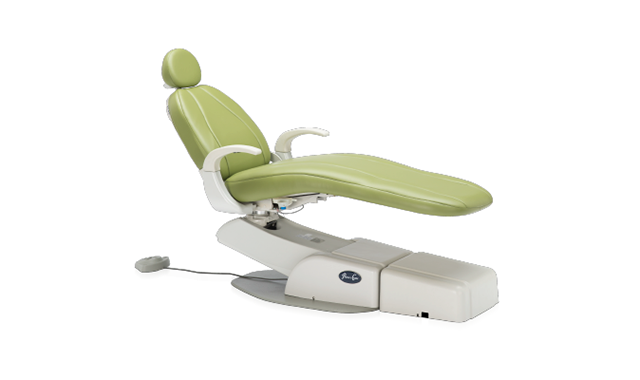
Dr. Goodchild also recovers his chairs that may look worn but are functioning fine. He had one A-dec unit for 25 years. He agrees that if you invest in a quality dental chair, you can “beat those to death,” but that there are limits to what is acceptable.
“There are a lot of dentists that want to do a MacGyver thing, which is to duct tape it up or minimally service it to keep it working. But at that point, it’s time to get a new chair,” Dr. Goodchild says.
Continue reading on the next page...
The equipment behind the scenes
Dr. Goodchild had an old Pelton & Crane stainless steel autoclave that he used for years. When it started to break down, they rigged it up to keep it functioning properly. He probably would still be using it if the service guy had not made the call.
“The guy came to service it and said, ‘Hey, man. I can’t fix this unit anymore. It’s just dead. Just let it go,’” Dr. Goodchild says, laughing.
Part of the reason Dr. Goodchild didn’t replace it right away was that it was not patient-facing. In this case, the unit was sterilizing instruments appropriately, but the unit itself looked beat up and old. Replacing patient-facing items is essential because they can affect the patient’s perception of the practice and their overall experience.
The patient perception was a critical factor at Dr. Goodchild’s practice. He used to ask his dental assistant to sit in the chair and look around the operatory to see what the patient sees. If something looked old or dirty, they looked for ways to improve it.
“Things that are outward-facing, you can’t beat to death, but things that are behind the scenes are different,” Dr. Goodchild says.
In addition to the autoclave, he says he had a compressor in the basement that was approximately 20 years old and a polishing lathe that was nearly 40 years old. Both were working fine despite their age. Because patients didn’t see them, he didn’t replace them.

However, by that same token, quality equipment is more expensive, so you need to build replacements into your budget. Dr. Goodchild says sometimes replacing a non-patient facing piece of equipment, such as your autoclave, can be an unplanned expense that puts a significant crimp in your bottom line.
“You don’t expect it to go out because it has held on for the last 20 years, but then all of a sudden, it dies on you, and now you have to pay thousands of dollars,” Dr. Goodchild explains. “A smart dentist thinks about needing to replace it and budgeting the money to do it so that it isn’t such an unexpected inconvenience in the budget.”
Another benefit of pre-planning these behind-the-scenes expenses is you can take your time and make an informed decision. For example, if the 20-year-old compressor goes out, you can’t treat patients, so your concern is only to get it running as fast as possible no matter the cost. Now, Dr. Goodchild says, you have to get whatever you can get instead of what could be the most economical.
To think ahead, Dr. Goodchild suggests considering expenditures such as autoclaves or old compressors at the end of the calendar year, when many dentists are investing in equipment for tax reasons.
“Maybe this is the year you get your new compressor or sterilizer instead of all the new and shiny stuff that the rep wants to sell you at the end of the year,” Dr. Goodchild says.
